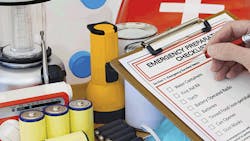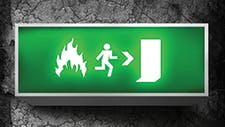Emergency Response Plans: Take an All-Hazard Approach
No matter how thick the binder containing a facility's emergency response plan is or how many times it has been reviewed and amended by consultants and professionals, it only is as strong as the abilities of the people performing each of the roles.
An organization's ability to communicate the elements of its response plan, as well as its dedication to training, drilling and exercising the plan regularly are the keys for a successful outcome when there is an emergency. While every facility's plan is unique, the following elements should be part of every emergency response plan.
Look for New Risks
Twenty years ago, emergency response plans tended to focus on fires and spill response. These plans met the letter of the law, and most still would be adequate to satisfy certain regulations. But being prepared for emergencies is much more involved than having clear exit routes and the tools and supplies onsite to clean up a spill. The risk of business interruptions stemming from natural disasters, acts of terrorism and workplace violence also need to be considered. Taking an all-hazard approach increases efficiency and helps simplify training.
The Department of Homeland Security has produced several resources to help businesses prepare for different types of emergencies. These are good resources, but they shouldn't be the only ones referenced when identifying risks and creating response plans.
Involving employees from different areas can help uncover risks that others may miss. Local resources, like your city or county emergency management agency, fire departments and hazmat teams also can provide valuable insight about risks from neighboring facilities or in the community that may impact operations or present safety risks.
Clearly Define Roles and Responsibilities
Is it more important to get out of the building right now, or to turn off a machine that could produce an additional hazard if it's left unattended – assuming it's safe to do so? Employees need to know what specific actions they are expected to take when there is an emergency. Even if their only action is to locate the nearest exit and get out, it should be documented in the plan and communicated and reviewed during training and regular drills.
Plans also should list the responsibilities of supervisors, emergency responders, public information officers, security personnel, front office staff and maintenance crews. Additionally, the plan should provide for the safety of visitors and outside contractors who may be on site, as well as anyone who has mobility challenges or would otherwise require assistance during an emergency.
Establish a Chain of Command
Under the federal National Incident Management System (NIMS), trained emergency responders are taught about "unity of command." This means that each person reports to one – and only one – designated person. During large response efforts, this helps to keep everyone focused on their specific roles and prevents personnel from getting pulled in too many directions. It also helps maintain span of control and accountability.
While it usually isn't necessary for everyone to fully understand every NIMS concept or be able to fill out a flow chart listing all of the positions, employees should understand that everyone has a responsibility and to whom they report. Chains of command also should specify who may talk to the media and the name of the individual responsible for liaising with outside responders, such as firefighters or other emergency services.
Mark Evacuation Routes
A good evacuation plan is more than just having an adequate number of exits and posting photocopies of a blueprint of the building with highlighted evacuation routes in halls or aisle ways. Evacuation routes need to make sense. It also helps if the routes are so unmistakable that a child could find his or her way out of the building unassisted.
Rally at Assembly Points
Getting everyone out of a building minimizes their risk of exposure and increases safety, but it can create another set of problems if exiting employees are blocking entrances that responders need to enter. Establishing assembly points that are away from the building gets people out of harm's way and also helps supervisors take attendance to ensure that everyone has made it safely out of the building.
In large disasters, assembly points also can help minimize the potential for reporters hoping for a statement to single out employees. And when assembly points are sheltered, they keep employees and visitors out of inclement weather.
Store Response Supplies Prominently
Because emergency response supplies usually aren't needed every day, it's easy for them to be seen as clutter and for them to be relocated to a back corner or placed in the last aisle of a stockroom. This especially can be true in workplaces where training is lax, because employees may not know how to use any of the items stored in the kits or cabinets or be able to explain why the items are onsite.
Response supplies should be stored where they most likely will be needed. For example, spill kits should be stored near chemical dispensing areas, production lines, waste collection rooms and loading docks. Items like first aid kits and defibrillators should also be easy to get to – not hung in a lobby or tucked in a remote break room.
Plans should specify the location of response tools and supplies, and include an inspection schedule to ensure that supplies are stocked and available. Marking the floors or walls with hi-viz paint, tape or signs can serve as a reminder of the location of response supplies. It's common for response supplies to be pilfered and for kits and cabinets to be empty when emergencies arise, so adding them to weekly or monthly checklists can help ensure that they remain properly stocked.
Communicate Updates and Changes
Change is constant. Supervisors move to different positions, floor plans are modified, new risks are identified and different resources may have been purchased to help during an emergency response. Too often, changes like these don't make it into written plans, nor are they communicated to employees.
Training and exercises can be catalysts for plan changes. As employees gain new response skills or engage in additional training opportunities, plans need to reflect these changes. Conversely, if an exercise reveals that a majority of employees weren't able to follow the plan or they are uncomfortable doing what the plan tells them to do, then the plan needs to be reviewed and possibly changed.
That's why it's so important to make time after drills and exercises for everyone to provide feedback. It is very rare for a drill or exercise to have gone so well that there is no room for improvement.
Implement Routine Training, Drills and Exercises
One reason that routines and standard operating procedures work is because they are repetitive. When it comes to emergency response, routines and procedures can get rusty because they are seldom used. The more often employees participate in training, drills and exercises, the more likely it will be that everyone remembers what to do in case of an emergency – even if they don't practice response skills every day.
Having an emergency response plan on paper is one step in being prepared. But, without open lines of communication, training, drills and exercises, employees may not have the skills necessary to instinctively handle emergency situations. Making the time to ensure that all employees know their roles during an emergency helps to ensure a more successful and safe response.
Karen D. Hamel, WACH, is an EHS specialist and technical writer for New Pig. She has more than 21 years of experience helping environmental, health and safety professionals find solutions to meet EPA, OSHA and DOT regulations and has had more than 100 articles published on a variety of EHS topics. Karen is a walkway auditor certificate holder (WACH) hazmat technician, serves on the Blair County, Pa., LEPC, is a CERT trainer and has completed a variety of environmental, safety, emergency response and NIMS courses, including planning section chief. She can be reached at 1-800-HOT-HOGS (468-4647) or by email at [email protected].

